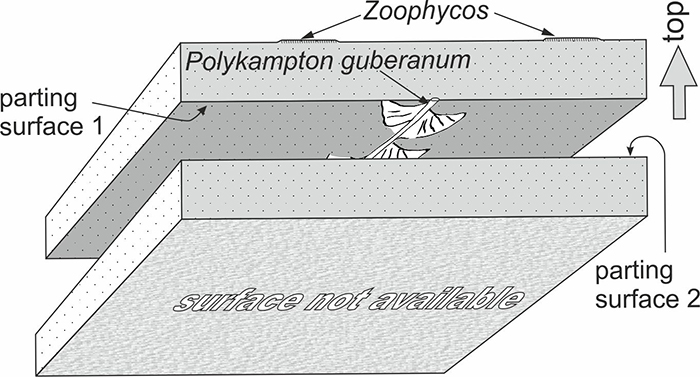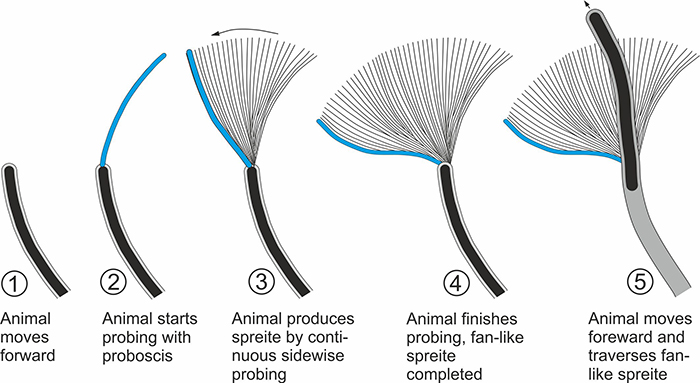FIGURE 1. Location maps: 1, areas (2-4) with localities of key specimens presented in this paper. 2, location of Polykampton guberanum isp. nov. in Bisamberg, Austria; 3, location of P. alpinum (type material) in Fégire, and P. guberanum isp. nov. in Guber, both in Switzerland; 4, location of P. multiflabellatum isp. nov. in the Aveto Valley, Italy.

FIGURE 2. Type material of Polykampton alpinum Ooster, 1869 from Fégire, Switzerland, housed in the Naturhistorisches Museum der Burgergemeinde Bern: 1, the lectotype, hypichnion, slab 5017075; white quadrangle marks details shown in 4; 2, paralectotype, epichnia, slab 5017076; 3, side view of the lectotype, slab 5017075; 4, detail of A; 5, original label of the lectotype; 6, copy of plate 4 from Ooster (1869) showing the original illustration.

FIGURE 3. Polykampton alpinum Ooster from the Guber quarry, Switzerland. Specimen NHMW 2018/0158/0001 of the Naturhistorisches Museum in Vienna; it derives from the Gurnigel-Schlieren Flysch in Switzerland.

FIGURE 4. Drawings of Polykampton ichnospecies made by authors on the basis of photographs from different publications and collections for a comparison: 1, Polykampton alpinum, the lectotype (see Figure 2.1); 2, P. alpinum, a fragment of paralectotype (see Figure 2.2); 3, P. alpinum, based on Makarenko, 1973, p. 220, figure on p. 221; 4, P. alpinum, based on Zuber, 1918, figure 76; 5,. P. alpinum, based on Novák and Peslová, plate 20 (a fragment); 6, P. guberanum (see Figure 5.5); 7, P. cabellae, based on Uchman and Rattazzi, figure 2A; 8, P. eseri, based on Uchman, 1999, plate 13, figure 3; 9, P. multiflabellatum, based on specimen 7408, Museo Paleontologico di Crocefieschi.

FIGURE 5. Polykampton guberanum isp. nov.: 1, specimen NML 1995-11a (h-holotype) of the Naturmuseum Luzern, parting surface 1 (see Figure 6) of fine-grained sandstone bed; 2, detail of 1, the holotype showing well-developed spreite lobes and the median tunnel of variable width; 3, detail of 1 showing branched form; 4, Detail of counterpart slab (specimen NML 1995-11b, parting surface 2, see Figure 6) showing lobes only partly crossed by the median tunnel; 5, Specimen O155 of the Naturhistorisches Museum Basel.

FIGURE 6. Position of Polykampton guberanum isp. nov. in specimens NML 1995-11a (top part), b (basal part) of the Naturmuseum Luzern (see Figure 5).

FIGURE 7. Polykampton multiflabellatum isp. nov., positive hypichnia on sandstone slabs from the Ottone Formation (lower-middle Campanian), Italy, housed in the Museo Paleontologico di Crocefieschi: 1, holotype (h), He-Helminthoidichnites isp., slab 7408; 2, paratype 2, slab 6852; 3, paratype 1, slab 6851; 4, specimen showing foremost the median tunnel, slab 7060; 5, specimen showing foremost the median tunnel, He-Helminthoidichnites isp., slab 7061, 6, bioglyphs of the slab 7331.

FIGURE 8. Other specimens of Polykampton multiflabellatum isp. nov.: 1, specimen A 6349 of the Naturhistorisches Museum in Vienna, which derives from the Kahlenberg Beds (upper Campanian-lowermost Maastrichtian), Austria; 2, details of P. multiflabellatum isp. nov., hypichnion in sandstone slab 7449 from the Ottone Formation (lower-middle Campanian), Italy, housed in the Museo Paleontologico di Crocefieschi. Numbers 1-5 indicate a succession of spreite bundles. The lobe is covered by scratches (sc) obliquely oriented to the bundles.

FIGURE 9. Saportia striata (Squinabol, 1888), specimens 2404 and 2450 (in fact one slab broken) of the University of Genova, Italy. Monte Antola Formation (late Campanian-Maastrichtian), Madonna del Monte, Genova, Italy. Proximal part of the lobes (l1-l6) can be interpreted. This ichnotaxon can be reservedly included in Polykampton.

FIGURE 10. Formation of lobes in Polykampton guberanum by a “worm” having long proboscis.

FIGURE 11. Model of Polykampton alpinum, P. guberanum and P. multiflabellatum. Arrows show direction of development of the lobes by strip mining.


